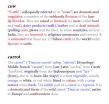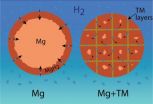(Press-News.org) Solar power is not all sunshine. It has a dark side—particularly in developing countries, according to a new study by a University of Tennessee, Knoxville, engineering professor.
A study by Chris Cherry, assistant professor in civil and environmental engineering, found that solar power heavily reliant on lead batteries has the potential to release more than 2.4 million tons of lead pollution in China and India.
Lead poisoning causes numerous adverse health effects, including damage to the central nervous system, the kidneys, the cardiovascular system, and the reproductive system. In children, blood lead concentration is associated with learning impairments, as well as hyperactive and violent behavior.
His study, co-authored with Perry Gottesfeld of Occupational Knowledge International (OK International), appears in the September issue of the journal Energy Policy.
Lead pollution predicted to result from investments in solar power by 2022 is equivalent to one-third of current global lead production. The researchers, who relied on official government plans for deploying solar power to make these projections, also found that the countries have large amounts of lead leak into the environment from mining, smelting, battery manufacturing, and recycling—33 percent in China and 22 percent in India. Also, a large percentage of new solar power systems continues to be reliant on lead batteries for energy storage due to the inadequate power grid in these countries.
The study's release comes on the heels of reports of a large number of mass lead poisoning incidents around lead battery recycling and manufacturing plants in China and the announcement that the country recently closed 583 of these facilities.
"Investments in environmental controls in the lead battery industry, along with improvements in battery take-back policies, are needed to complement deployment of solar power in these countries," said Cherry. "Without improvements, it is increasingly clear that the use of lead batteries will contribute to environmental contamination and lead poisoning among workers and children."
The battery industry is the largest consumer of lead, using approximately 80 percent of global lead production. Lead battery manufacturing is growing rapidly in much of the world to meet demand for batteries for solar power and other applications. With the authors' projected emissions, they say this will impact public health and contribute to environmental contamination.
"The solar industry has to step up and take responsibility for ensuring that their lead battery suppliers are operating with adequate controls as long as they are going to be reliant on this technology," said Gottesfeld. "Without major improvements in the manufacturing and recycling lead batteries in these countries, we expect that lead poisoning will increase as the industry grows."
The projections outlined in the study, while based on plans articulated by these two countries, are likely to be repeated throughout much of the developing world, such as in Africa.
###OK International is a nongovernmental organization dedicated to improving public health in developing countries through innovative strategies to reduce exposures to industrial pollutants. For more information, visit www.okinternational.org.
Solar industry responsible for lead emissions in developing countries
Solar power is not all sunshine; it has a dark side—particularly in developing countries, according to a new study by a University of Tennessee, Knoxville, engineering professor
2011-09-01
ELSE PRESS RELEASES FROM THIS DATE:
Word association: Princeton study matches brain scans with complex thought
2011-09-01
In an effort to understand what happens in the brain when a person reads or considers such abstract ideas as love or justice, Princeton researchers have for the first time matched images of brain activity with categories of words related to the concepts a person is thinking about. The results could lead to a better understanding of how people consider meaning and context when reading or thinking.
The researchers report in the journal Frontiers in Human Neuroscience that they used functional magnetic resonance imaging (fMRI) to identify areas of the brain activated when ...
Iron 'Veins' Are Secret of Promising New Hydrogen Storage Material
2011-09-01
With a nod to biology, scientists at the National Institute of Standards and Technology (NIST) have a new approach to the problem of safely storing hydrogen in future fuel-cell-powered cars. Their idea: molecular scale "veins" of iron permeating grains of magnesium like a network of capillaries. The iron veins may transform magnesium from a promising candidate for hydrogen storage into a real-world winner.
Hydrogen has been touted as a clean and efficient alternative to gasoline, but it has one big drawback: the lack of a safe, fast way to store it onboard a vehicle. ...
Registration Opens September 1 for 4th Annual Renton FilmFrenzy, a 50-Hour Filmmaking Competition with $1,700 in Cash Prizes; Filmmakers will Take Over Renton from Oct. 7-9
2011-09-01
It will be "lights, camera, action" in Renton from October 7-9, when aspiring, ahead of the curve filmmakers take over the city for the fourth annual Renton FilmFrenzy, a 50-hour filmmaking competition. Last year, 25 filmmaking teams competed for $1,700 in cash prizes and the coveted Curvee Awards.
"Thanks to our partnerships with SIFF, Reel Grrls, theFilmSchool, area filmmaking programs, and the Renton Arts Commission, the Renton FilmFrenzy continues to expand and has become an integral part of the growing and strong Renton arts community," said ...
Sandfly saliva provides important clues for new Leishmaniasis treatments
2011-09-01
Bethesda, MD—For millions of people who live under the constant threat of Leishmania infection, a new discovery by Brazilian scientists may lead to new breakthroughs, preventing these parasites from taking hold in the body or reducing the severity of infections once they occur. In a new report appearing in the Journal of Leukocyte Biology (http://www.jleukbio.org), scientists show that specific molecules found in the saliva of the sandfly—a small flying insect that is the vector for the parasite—make it possible for Leishmania to evade neutrophils and live within human ...
Celebrate the Seventh Annual Cobra Polo Classic Benefiting Ronald McDonald House Charities
2011-09-01
Polo is possibly the oldest sport, period. The first experience with a mallet, pony and a round object were recorded nearly two thousand years ago. Polo is the sport known to royalty around the world.
On Sunday, September 11th over twelve-hundred guests will celebrate the seventh annual Cobra Polo Classic benefiting Ronald McDonald House Charities of Spokane. "It is the most prestigious event in the Inland Northwest," reports Mike Forness, RMHC of Spokane Executive Director. Sky divers, gourmet food and wine, cigar and Dry Fly whiskey tent, safari escape women's ...
SER2011 Mexico call to action
2011-09-01
The delegates of the Society for Ecological Restoration´s 4th World Conference on Ecological Restoration (SER2011) congratulate the Parties of the Convention on Biological Diversity (CBD) for their practical and forward looking Strategic Plan 2011-2020, including Targets 14 and 15 in which the Parties have agreed that by 2020, ecosystems of particular importance to water security, human health, and sustainable livelihoods are restored, and their resilience and contribution to carbon stocks enhanced, through conservation and restoration, including the restoration of at ...
2011 AAO-HNSF new oral research daily highlights
2011-09-01
San Francisco, CA – The 2011 Annual Meeting & OTO EXPO of the American Academy of Otolaryngology – Head and Neck Surgery Foundation (AAO-HNSF), the largest meeting of ear, nose, and throat doctors in the world, will convene September 11-14, 2011, in San Francisco, CA.
Featuring more than 386 scientific research sessions, 468 posters, and several hundred instruction course hours for attendees, the annual meeting is a unique opportunity for journalists from around the world to cover breaking science and medical news. Reporters will have access to the latest research and ...
Scientists unravel the cause of rare genetic disease: Goldman-Favre Syndrome explained
2011-09-01
Bethesda, MD—A new research report published in The FASEB Journal (https://www.fasebj.org) will help ophthalmologists and scientists better understand a rare genetic disease that causes increased susceptibility to blue light, night blindness, and decreased vision called Enhanced S-Cone Syndrome or Goldman-Favre Syndrome. In the report, scientists found that the expression of genes responsible for the healthy renewal of rods and cones in the retina was reduced and that this problem originates in the photoreceptors themselves rather than in the adjacent retinal pigment epithelial ...
'Pink ribbon dollars' help fill financial gaps for breast cancer programs
2011-09-01
A new study shows that donations collected by check boxes on state income tax forms, fees from license plates and revenue from state lottery tickets have raised millions for breast cancer research and prevention programs across the country, according to researchers at Washington University in St. Louis.
"We found that revenue-generating breast cancer initiatives can be a successful strategy for states to raise funds, or 'pink ribbon dollars,' for prevention and early detection programs," says Amy A. Eyler, PhD, research associate professor at the Brown School of Social ...
Carlsbad, New Mexico, to Host National Nuclear Fuel Cycle Summit
2011-09-01
The Carlsbad Department of Development (CDOD) has announced the first annual National Nuclear Fuel Cycle Summit, taking place April 2-5, 2012. The Summit will be hosted by Carlsbad, New Mexico, and will include renowned experts from the various nuclear-related industries across the nation.
Panel discussions will provide members of the public and policymakers with valuable insights into and strategies addressing our national nuclear fuel cycle policies, our nation's growing energy needs, nuclear waste management, regulation, and funding. A lively discussion on the highly ...
LAST 30 PRESS RELEASES:
Making lighter work of calculating fluid and heat flow
Normalizing blood sugar can halve heart attack risk
Lowering blood sugar cuts heart attack risk in people with prediabetes
Study links genetic variants to risk of blinding eye disease in premature infants
Non-opioid ‘pain sponge’ therapy halts cartilage degeneration and relieves chronic pain
AI can pick up cultural values by mimicking how kids learn
China’s ecological redlines offer fast track to 30 x 30 global conservation goal
Invisible indoor threats: emerging household contaminants and their growing risks to human health
Adding antibody treatment to chemo boosts outcomes for children with rare cancer
Germline pathogenic variants among women without a history of breast cancer
Tanning beds triple melanoma risk, potentially causing broad DNA damage
Unique bond identified as key to viral infection speed
Indoor tanning makes youthful skin much older on a genetic level
Mouse model sheds new light on the causes and potential solutions to human GI problems linked to muscular dystrophy
The Journal of Nuclear Medicine ahead-of-print tip sheet: December 12, 2025
Smarter tools for peering into the microscopic world
Applications open for funding to conduct research in the Kinsey Institute archives
Global measure underestimates the severity of food insecurity
Child survivors of critical illness are missing out on timely follow up care
Risk-based vs annual breast cancer screening / the WISDOM randomized clinical trial
University of Toronto launches Electric Vehicle Innovation Ontario to accelerate advanced EV technologies and build Canada’s innovation advantage
Early relapse predicts poor outcomes in aggressive blood cancer
American College of Lifestyle Medicine applauds two CMS models aligned with lifestyle medicine practice and reimbursement
Clinical trial finds cannabis use not a barrier to quitting nicotine vaping
Supplemental nutrition assistance program policies and food insecurity
Switching immune cells to “night mode” could limit damage after a heart attack, study suggests
URI-based Global RIghts Project report spotlights continued troubling trends in worldwide inhumane treatment
Neutrophils are less aggressive at night, explaining why nighttime heart attacks cause less damage than daytime events
Menopausal hormone therapy may not pose breast cancer risk for women with BRCA mutations
Mobile health tool may improve quality of life for adolescent and young adult breast cancer survivors
[Press-News.org] Solar industry responsible for lead emissions in developing countriesSolar power is not all sunshine; it has a dark side—particularly in developing countries, according to a new study by a University of Tennessee, Knoxville, engineering professor


